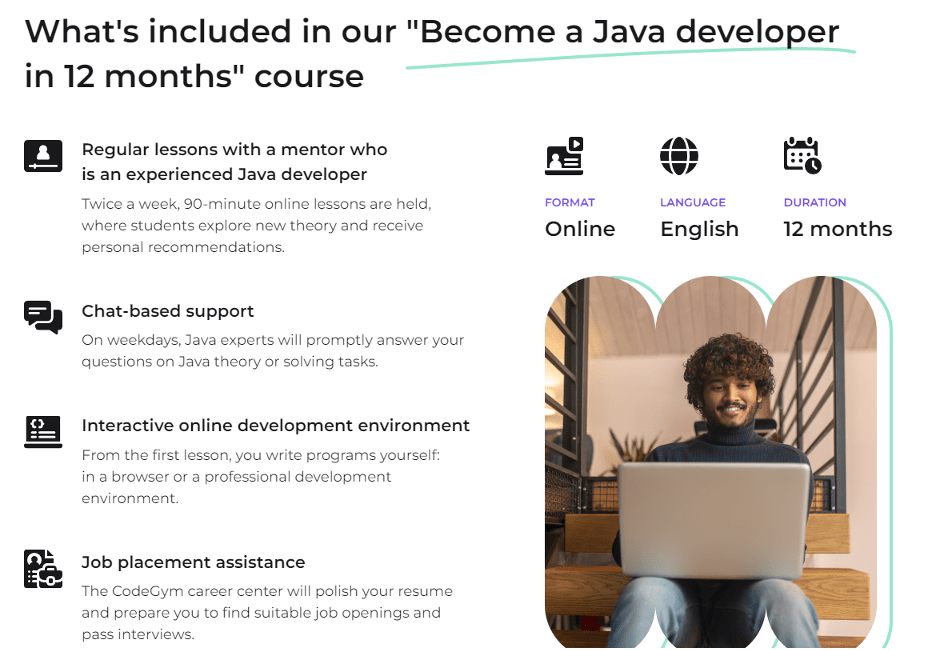Do you want to master Java and land your dream job as a Java developer? You may already know that Naukri.com, the largest Indian job searching site, now has nearly 100,000 job openings looking for Java developers. But how long will it take to learn Java?
The answer to that question is not as simple as you might think. Several factors will play into it, such as your past programming experience, whether you will be self-studying or taking a class, and how much time you are willing to devote to the learning process.
It also depends significantly on what resources you will use to learn Java. Today we will explore all of these factors to understand better how long it might take you to learn Java.

What do we mean by ‘Learn Java’?
Before we move into answering how long it takes to learn Java, let’s first establish what we mean by that. When we say “learn Java,” we don’t simply imply that you can write a “Hello, World!” program. To jumpstart your career as a Java Developer or Junior Java Developer, you need to be able to do much more than that!
You must be well-versed in the Java language, familiar with the Java programming ecosystem, and have practical experience developing Java applications.
In short, learning Java means being able to write Java code that is both correct and efficient for solving real-world problems within a professional setup. Simply put, you will have to learn Java well enough to make sufficient to grow your career as a professional Java Developer.
What are the Steps to Learning Java?
Let’s begin this discussion by answering the most basic question. What do you start with to Learn Java? Once you know the learning process, you will automatically get a fair idea of how much time it will take to become a professional Java developer.
Your entire Java learning journey will begin with Core Java, which you may think of as your alphabet.
Step 1: Learning the Core Java
No matter what developer pathway you want to pursue in the future, you will always start with Core Java. These include the fundamental concepts of the Java language and the basic syntax.
When learning and practising your Java syntax, you will also have to familiarize yourself with other topics such as class, method, primitive types, operators, if-else statements, arrays and loops, and string, all of which are fundamental concepts of this programming language.
Several other concepts are also integral parts of Core Java, which you will learn gradually. These include:
- OOP: OOP or Object Oriented Programming is one of the specialities of Java that lets you create objects with both data and methods simultaneously. A major advantage of OOP over procedural programming is that OOP lets you create completely reusable applications faster with fewer codes.
- Java Collections: Java Collections is a framework that provides you with several classes and interfaces that support data structures, such as lists, maps, sets, and queues. You will learn to use these data structures while working with Java applications to solve everyday tasks.
- Java Exceptions: Exceptions occur during program execution, disrupting the normal flow of the program’s instructions. Java exceptions are classified into two types: checked and unchecked. You will learn about both types of exceptions and how to handle them in your Java code.
- Algorithms and Puzzles: Algorithms are a fundamental part of computer science, and you must know how to use them while working on Java applications.
- Multi-threading: Multi-threading allows you to execute two or more threads simultaneously for maximum utilization of the CPU.
- Patterns: A solid idea about Java design patterns will make you familiar with the most common programming problems.
- Unit Testing: The unit testing process lets you observe your source code behaviour under different conditions. You can then identify and fix bugs early in the development process.
- Lambdas: Although it is technically possible to skip using Lambdas when you learn and practice Java, we have found many Java Developer positions at Naukri, specifically asking for fluency in code manipulation with lambda expressions. So we recommend you include it in your learning outline.
- Serialization: This is where things become advanced. Serialization in JSON, RMI, and socket will help you create your projects and even take those into professional ventures.
This list may seem overwhelming, but don’t fret – there are hundreds of practice lessons at CodeGym University to start learning Java from scratch.

Step 2: Learning the Java Add-ons
Once familiar with Java Core, the next task is to learn the Java add-ons as they help you participate in real-life projects. Some frequent examples are:
- Git
- JavaScript
- SQL
You won’t have to be a master of those at this stage. But a workable knowledge of each add-on will help you choose the right career track shortly.
Step 3: Choose and pursue your specialization
At this stage, you will have to choose your specialized career path. There are three main paths for you to choose from:
- Java Developer
- Mobile App Developer
- QA Automation
Also Read: How to Become a Software Developer Fast?
How Long Does It Take To Learn Java?
Three key factors will determine your approximate time duration for learning Java. These are:
- Your level of expertise in the programming language
- The time you will invest every day in practice
- The career path you will pursue (Java/Mobile App/QA)
CodyGym surveyed several students, which revealed the following trends for those who practised 3-4 hours/day, 5-7 days/week:
| Level of Expertise | Java Developer | Mobile App Developer | QA Automation |
| Rookies (zero experience) | 16 months | 13 months | 7 months |
| Middle (some basic programming knowledge from school or college) | 11 months | 8 months | 4 months |
| Pro (knows one or more programming languages) | 3.5 months | 3.5 months | 3 months |
Based on our research and industry data, you can master Java from scratch to become job-ready within 12 months. However, there’s one catch. You must have access to good resources, mentorship, and practice materials.
What is the Best Place to Learn Java in India?
CodeGym Java University in India makes you 100% job-ready as a Junior Java Developer in 12 months.
Here are some highlights of the CodeGym University Java course:
- 100% job guarantee with support from industry-leading mentors
- Designed for beginners with zero programming knowledge
- Lots of fun materials and practices
- Small groups and Zoom lessons
- Homework and course projects
- Support through Slack communications
- Professional certification
- Focus on practical and result-oriented learning

This 12-month course is an excellent option for anyone who wants to switch industries and make a fresh start in their career as a Java developer.
Final Words
It’s never too late to start learning Java. If you are motivated enough to jumpstart your career as a Junior Java Developer within 12 months, you can achieve it. The Java developer community is vibrant and resourceful.
If you want to get top-quality guidance, mentorship, and hundreds of real-life practice materials, CodeGym Java University has you covered. Want to learn more about CodeGym? Book your seat in the CodeGym webinar now.
The post How Long Does It Take To Learn Java? appeared first on The Crazy Programmer.
from The Crazy Programmer https://ift.tt/qY5jSJL
Comments
Post a Comment